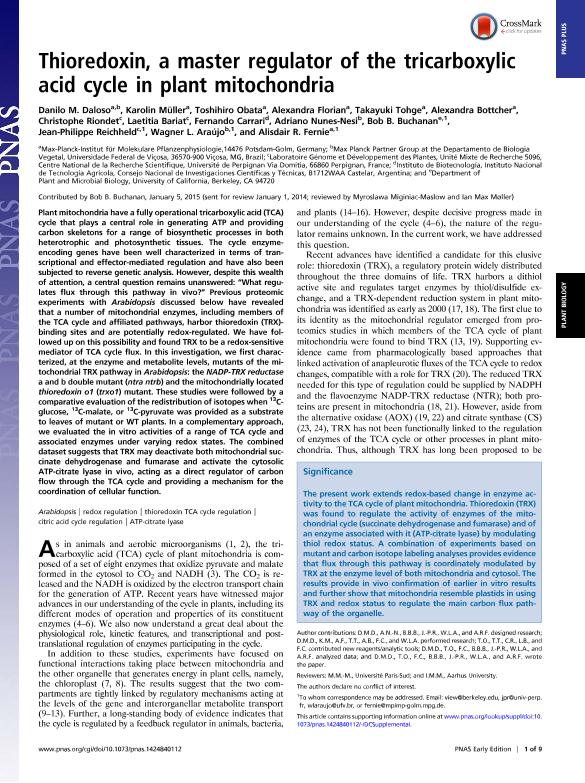Mostrar el registro sencillo del ítem
dc.contributor.author
Daloso, Danilo M.
dc.contributor.author
Müller, Karolin
dc.contributor.author
Obata, Toshihiro
dc.contributor.author
Florian, Alexandra
dc.contributor.author
Tohge, Takayuki
dc.contributor.author
Bottcher, Alexandra
dc.contributor.author
Riondet, Christophe
dc.contributor.author
Bariat, Laetitia
dc.contributor.author
Carrari, Fernando Oscar

dc.contributor.author
Nunes Nesi, Adriano
dc.contributor.author
Buchanan, Bob B.
dc.contributor.author
Reichheld, Jean-Philippe
dc.contributor.author
Araújo, Wagner L.
dc.contributor.author
Fernie, Alisdair R.
dc.date.available
2018-03-09T19:25:33Z
dc.date.issued
2015-03
dc.identifier.citation
Daloso, Danilo M.; Müller, Karolin; Obata, Toshihiro; Florian, Alexandra; Tohge, Takayuki; et al.; Thioredoxin, a master regulator of the tricarboxylic acid cycle in plant mitochondria; National Academy of Sciences; Proceedings of the National Academy of Sciences of The United States of America; 112; 11; 3-2015; E1392-E1400
dc.identifier.issn
0027-8424
dc.identifier.uri
http://hdl.handle.net/11336/38435
dc.description.abstract
Plant mitochondria have a fully operational tricarboxylic acid (TCA) cycle that plays a central role in generating ATP and providing carbon skeletons for a range of biosynthetic processes in both heterotrophic and photosynthetic tissues. The cycle enzyme-encoding genes have been well characterized in terms of transcriptional and effector-mediated regulation and have also been subjected to reverse genetic analysis. However, despite this wealth of attention, a central question remains unanswered: "What regulates flux through this pathway in vivo?" Previous proteomic experiments with Arabidopsis discussed below have revealed that a number of mitochondrial enzymes, including members of the TCA cycle and affiliated pathways, harbor thioredoxin (TRX)-binding sites and are potentially redox-regulated. We have followed up on this possibility and found TRX to be a redox-sensitive mediator of TCA cycle flux. In this investigation, we first characterized, at the enzyme and metabolite levels, mutants of the mitochondrial TRX pathway in Arabidopsis: the NADP-TRX reductase a and b double mutant (ntra ntrb) and the mitochondrially located thioredoxin o1 (trxo1) mutant. These studies were followed by a comparative evaluation of the redistribution of isotopes when 13C-glucose, 13C-malate, or 13C-pyruvate was provided as a substrate to leaves of mutant or WT plants. In a complementary approach, we evaluated the in vitro activities of a range of TCA cycle and associated enzymes under varying redox states. The combined dataset suggests that TRX may deactivate both mitochondrial succinate dehydrogenase and fumarase and activate the cytosolic ATP-citrate lyase in vivo, acting as a direct regulator of carbon flow through the TCA cycle and providing a mechanism for the coordination of cellular function.
dc.format
application/pdf
dc.language.iso
eng
dc.publisher
National Academy of Sciences

dc.rights
info:eu-repo/semantics/openAccess
dc.rights.uri
https://creativecommons.org/licenses/by-nc-sa/2.5/ar/
dc.subject
Arabidopsis
dc.subject
Atp-Citrate Lyase
dc.subject
Citric Acid Cycle Regulation
dc.subject
Redox Regulation
dc.subject
Thioredoxin Tca Cycle Regulation
dc.subject.classification
Otras Ciencias Biológicas

dc.subject.classification
Ciencias Biológicas

dc.subject.classification
CIENCIAS NATURALES Y EXACTAS

dc.title
Thioredoxin, a master regulator of the tricarboxylic acid cycle in plant mitochondria
dc.type
info:eu-repo/semantics/article
dc.type
info:ar-repo/semantics/artículo
dc.type
info:eu-repo/semantics/publishedVersion
dc.date.updated
2018-03-08T19:02:43Z
dc.journal.volume
112
dc.journal.number
11
dc.journal.pagination
E1392-E1400
dc.journal.pais
Estados Unidos

dc.journal.ciudad
Washington
dc.description.fil
Fil: Daloso, Danilo M.. Institut Max Planck Fur Molekulare Physiologie; Alemania. Universidade Federal de Vicosa; Brasil
dc.description.fil
Fil: Müller, Karolin. Institut Max Planck Fur Molekulare Physiologie; Alemania
dc.description.fil
Fil: Obata, Toshihiro. Institut Max Planck Fur Molekulare Physiologie; Alemania
dc.description.fil
Fil: Florian, Alexandra. Institut Max Planck Fur Molekulare Physiologie; Alemania
dc.description.fil
Fil: Tohge, Takayuki. Institut Max Planck Fur Molekulare Physiologie; Alemania
dc.description.fil
Fil: Bottcher, Alexandra. Institut Max Planck Fur Molekulare Physiologie; Alemania
dc.description.fil
Fil: Riondet, Christophe. Centre National de la Recherche Scientifique; Francia
dc.description.fil
Fil: Bariat, Laetitia. Centre National de la Recherche Scientifique; Francia
dc.description.fil
Fil: Carrari, Fernando Oscar. Consejo Nacional de Investigaciones Científicas y Técnicas; Argentina. Instituto Nacional de Tecnología Agropecuaria. Centro de Investigación en Ciencias Veterinarias y Agronómicas. Instituto de Biotecnología; Argentina
dc.description.fil
Fil: Nunes Nesi, Adriano. Universidade Federal de Vicosa; Brasil
dc.description.fil
Fil: Buchanan, Bob B.. University of California at Berkeley; Estados Unidos
dc.description.fil
Fil: Reichheld, Jean-Philippe. Centre National de la Recherche Scientifique; Francia
dc.description.fil
Fil: Araújo, Wagner L.. Universidade Federal de Vicosa; Brasil
dc.description.fil
Fil: Fernie, Alisdair R.. Institut Max Planck Fur Molekulare Physiologie; Alemania
dc.journal.title
Proceedings of the National Academy of Sciences of The United States of America

dc.relation.alternativeid
info:eu-repo/semantics/altIdentifier/url/http://www.pnas.org/content/112/11/E1392.short
dc.relation.alternativeid
info:eu-repo/semantics/altIdentifier/doi/http://dx.doi.org/10.1073/pnas.1424840112
Archivos asociados
